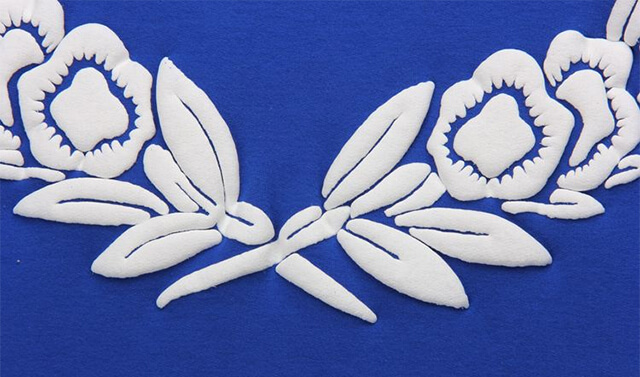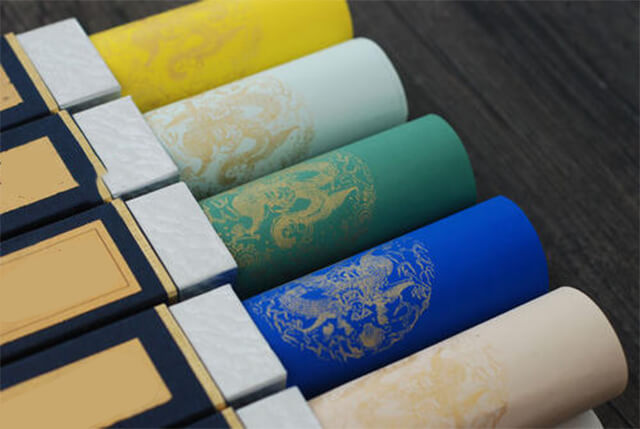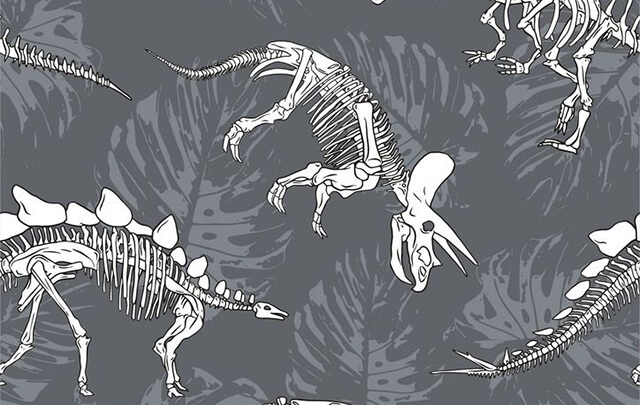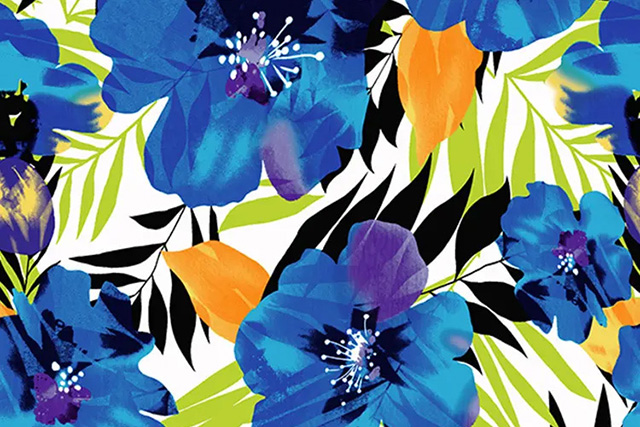17 digital printing methods commonly used in knit printing
Editor: SunHing │ Date: April 11, 2023
1, pearlescent, luminous printing
Pearlescent has natural and artificial points that extract artificial pearlescent light from fish scales. Pearl light does not require excitation by light source, acid and alkali resistance, and high temperature resistance. Pearlescent prints show the soft brilliance of pearls and gracefulness, with excellent hand and fastness. Pearlescent paste is suitable for a variety of fiber printing, either alone or in combination with a coating to produce colored pearlescent. In the printing process, it is generally preferred to use a 60-80 mesh screen. The luminescent printing is mainly printed on the surface of the fabric by using a luminescent crystal, and the luminescent paste is fixed on the fabric by pre-baking and melting. Mainly used in elastic interwoven products of polyamide and spandex.

2, luminous printing
Luminous powder is a kind of rare earth metal, which is made into a powder with a fineness of about 1 μM. The paint is printed on the fabric to form a pattern. After a certain amount of light, the afterglow time of the flower pattern can reach 8-12 hours, which has good luminescent effect and excellent hand feeling and fastness. However, it is limited to printing on the light-colored ground color.
3, foam three-dimensional printing
The foamed three-dimensional printing refers to adding a foaming agent plastic resin to the printing paste. After the high temperature melting, the foaming agent is decomposed, and when the gas is released, the printing paste is expanded to form a three-dimensional pattern, and the coating is fixed by means of the resin to obtain coloring and The three-dimensional effect of foaming. According to the process, one is directly printing the foaming pulp, and the other is to blow the dry foaming paste after printing, and then use the elastic transparent pulp to imprint on the foaming pulp to blow dry, high-temperature foaming molding. Foaming temperature Generally at 110 ° C, time 30 seconds, the printing uses 80-100 mesh screen.

4, capsule printing
The microcapsules are composed of an inner core and a capsule, the inner core is a dye, the capsule is gelatin, the microcapsules are single core type, multi-core type and composite type, the single core type contains one dye, and the multi-core type contains a plurality of types. Dye, composite type composite microcapsule composed of a multilayer outer film. The particles of the microcapsule dye are between 10 and 30 μM.
5, matt printing (imitation jacquard printing)
The water-repellent slurry containing the matting agent on the light fabric is coated with a paint printing process to obtain a partial matte printing effect, which is distinct in light and dark, and has a jacquard-like style. The matting paste is generally composed of titanium dioxide or paint white as a matting agent, and is composed of a non-yellowing binder. Mainly used in satin or twill silk, rayon, synthetic fiber, cellulose fiber knitted fabrics and blended fabrics, can also be used on calendered fabrics and sample paper.
6, gold and silver powder printing
The gold powder or silver powder is mixed with a special high-quality silver or silver powder special paste or adhesive, and printed on the fabric to form a golden or silver glitter pattern effect.

7, shrapnel printing
The scintillation sheet is a vacuum-aluminized metal sheet with various colors, thickness of 0.008mm-0.1mm, and high temperature resistance. The scintillation film printing should be strong in adhesion, transparent in film formation, good in gloss, and does not affect the glittering luster and the special printing paste to be printed. It is necessary to ensure that the fabric feels soft and has good fastness and achieves a dazzling effect.
8, gold foil printing (hot stamping)
The special gold foil is used for printing on the printed fabric, and after being dried, the aluminum foil is coated, and after high temperature pressing, the effect of bronzing is obtained. Special gold foil paste is a thermoplastic resin type water-based latex paste. It has soft hand feeling, good brightness, good fastness and stickiness. It can be used for any fabric with high temperature resistance of 1600 °C.
9, imitation peach printing
Imitation peach skin printing is the use of imported peach skin special pulp (or coating), through the printing to achieve the surface feel and appearance of peach skin effect. The peach peel has a strong hiding power and is more suitable for printing on large blocks. It does not expose the ground or block the net. It can be printed on flat nets and round nets.
10, imitation leather printing
The imitation leather print is printed on the fabric with imitation leather pulp and paint. After drying and baking, it can achieve the imitation leather feel and appearance. The leather-like pulp has good elasticity and hiding power.
11, imitation velvet printing
The imitation velvet print is printed on the fabric with gold and silver velvet pulp, dried and baked to obtain a velvet-like velvety and luster.
12, contrast dark print
The color is deepened and the paste is printed on the color ground, and after drying, the dark and light contrast dark print effect is obtained. The printed fabric does not need to be melted, has a soft hand and good color fastness.

13, color coating printing (gloss printing)
The printing method is adopted by using the gloss paste and the paint color paste, and the fabric is dried and baked to obtain a coating and coating effect on the surface of the fabric.
14, photosensitive color printing
Using the principle of absorbing ultraviolet light and converting it into energy, the photosensitive color-changing material is applied to the printing, and the printed product is irradiated with sunlight and ultraviolet rays to absorb the energy of sunlight and ultraviolet light to produce a color change. When sunlight and ultraviolet rays are lost, That is, immediately return to the original color. Photochromic paste is made by microcapsule technology, and the fabric is colorless and variable in color, blue and blue and purple.
15, temperature-sensitive color printing
The temperature-sensitive color-changing material is printed on the fabric to change the temperature through the human body, and the color is changed repeatedly. The temperature-sensitive color-changing paste is 15 basic colors, low-temperature colored, high-temperature colorless, and the colors are mixed and toned.
16, thermal transfer printing
Clothing thermal transfer printing is usually divided into hot-melt transfer printing and sublimation transfer printing. Thermal sublimation type transfer printing can be divided into: offset printing, gravure printing, silk screen printing and data printing. In thermal transfer printing, the pattern is first printed on paper with a dispersion-containing dye and a printing ink, and then the transfer paper and the unprinted face-to-face are pasted together by a thermal transfer printing machine at about 210 ° C (400 T). By the machine, at such high temperatures, the dye on the transfer paper sublimes and transfers to the fabric, completing the printing process without further processing.

17, scent finishing printing
Using a new technology of slow-release pressure-sensitive microcapsules, the scented resin is added to the paint paste for printing, so that the scented resin is adhered to the cloth by the binder in the paint paste, and is firmly crosslinked by the baking and the fiber. Fixed on the cloth surface, the fragrance can be released for more than 6 months.

